|

by Dan Eden
from
MondoVista Website
|
ViewZone asked me to write
a story about the Mayan Calendar. There is a common
belief that the calendar holds a prophecy that the end
of the world will happen in 2012. At the time, I knew
very little about the whole topic and when I began doing
the research. I like to think I had an open mind. My
investigation began with mainstream archaeology and the
expert interpretations of the calendar. But it soon took
a turn that made my hair literally stand on end. I am
now convinced that these prophecies are true.
To understand what is likely to happen to Earth and it's
people, you will need to remain calm and try to follow
the facts. It's not as simple as some people describe.
It requires an understanding of some fairly complicated
scientific realities, but I think I can explain them in
a way that you will easily understand. |
The Calendar -
A Description
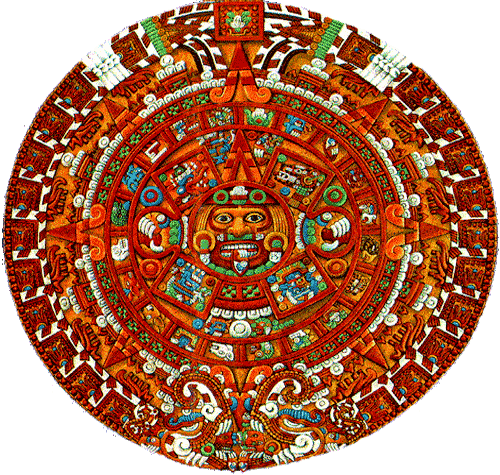
First,
the Mayan calendar is also
sometimes called the Aztec Calendar.
This calendar is recorded as a carving
on the Aztec "sun stone" currently on exhibit in the National Museum
of Anthropology and History located within Chapultepec Park, Mexico
City. There's a lot we could say about the carved stone but most of
those details are irrelevant to the end times.
In our modern calendar, called the Gregorian Calendar, we have days,
weeks, months and years.
In the Mayan Calendar it's more complex.
In fact, it's really three calendars. First there's a religious
calendar that takes 260 days to complete a full religious cycle.
There are 20 "weeks" made up of 13 days. Each week has a special
name, a graphic logo and unique meaning associated with it. This
rather reminds me of the Chinese years which cycle through "the year
of the rat" and "the year of the monkey," etc., each with it's
special image and meaning.

Graphic logos for
each of the 20 religious weeks
Next there is the solar calendar.
This
has 365 days, like our modern calendar. It's divided in 18 months of
20 days each. At the end of the cycle there's five special days
considered to be unlucky because they don't belong to any month.
Each of the months has a special name, graphic logo and some special
significance.
So it is possible, for any specific date, the calculate the
religious week and the solar month and to predict the influences
that might be guiding fate. But that's not really what's involved
with the prophecy of 2012. To understand that we must look at the
third calendar, called the "long count."
While the first two cycles could be thought of as cogs or gears,
revolving through time, the long count is a linear number of days,
starting from the first day, "1," and counting through each day to
the present. Any day in history can be recorded using the long count
and, with some fancy mathematics, the corresponding religious week
and solar month can also be found.
In writing this article, I thought about creating a javascript
program that would do this calculation. My friend, Gene Matlock,
then told me that when he was in Mexico, he found a place that sold
wooden, mechanical calculators with gears that did just that. He
said that Mexicans sometimes used these mechanical calendars to
foretell the future or to find auspicious times for special events
like marriage or births. Anyway, although it might be nice to know
the religious and solar significance, it's the long count that
foretells Doomsday.

Cog or "gears"
can be used to compute the religious and solar cycles for any date
The days of the long count are numbered
with an unusual system. Instead of writing numbers as we do, from
right to left with each place being a multiple of 10 (i.e. 10000,
1000, 100, 10, 1), the Mayans had only 5 places.
The first place recorded a number from 0 to 20. To the left, the
second place could have a range from 0 to 17; the third from 0 to
19; the fourth from 0 to 19 and the last from 0 to 12. The numbers
were written from right to left, like our system, separated by a
dot. Instead of multiples of 10, the first place had a multiple of 1
(like our system); the second place a multiple of 20; the third a
multiple of 360; the fourth a multiple of 7200 and the fifth a
multiple of 144000.
So a long count number, for example, could be written as 4.12.5.9.0
and would be calculated as follows:
(4 x 144000) + (12 x 7200) + (5 x
360) + (9 x 20) + (0 x 1) or a long count of 145980.
It's not too difficult to realize that
the maximum number which can be recorded this way would be
12.19.19.17.20, although some researchers like to write it as
13.0.0.0.0. This amounts to a long count number of 1,872,000 days or
5125.36 years of our modern calculations. Obviously, the calendar is
very old!
Over the years, archaeologists have found carved monuments that
recorded the long count for known dates in Mayan history. Once a
date was fixed in time, it was easy to determine the "day 1" as
August 11th, 3114 BC. And it was also easy to calculate the date at
which the calendar would end -- December 21st, 2012.
Trust me, just because the calendar ends doesn't prove that time, or
the world, or life will end. We need to look carefully at December
21, 2012 and try to understand why the Mayans never calculated a
date beyond this point in time. To do this we must move from
Archaeology to the science of Astronomy and Astrophysics.
It's all about the Sun It's ironic (or maybe not) that the Mayan
Calendar is often called the "sun stone." While the calendar does
have "solar" days, acknowledging the 365 days it takes for Earth to
rotate around the celestial body, it is also true that the Sun plays
a key role in the final day of the "long count." To understand what
will happen to the Sun on December 21, 2012, we need to review some
scientific terms like "ecliptic," "barycenter," and "sunspots."
These are important in the discussion that follows.
We'll start with
the most difficult one first.
Terms we will encounter...
What is the Barycenter?
You've no doubt heard that Earth revolves around the sun. Well,
actually, that's not quite true!
Have you heard the term "center of gravity"? It's a
technical-sounding term for something pretty simple. It's the exact
center of all the material (that is, mass) that makes up the object.
For example, if you have a straight stick, like a ruler or
yardstick, there's a place at the middle where you can balance it on
your finger. That's its center of gravity.

But the center of gravity may or may not
be the point that is exactly in the middle, distance-wise, of the
object. Some parts of the object may be heavier (denser) than
others. If you have something like a sledge hammer that is heavier
on one end than the other, the center of gravity will be much closer
to the heavy end than the lighter end.

To get an idea of where the center of
gravity is, rest the ends of any object like the ruler or a pencil
on one finger from each hand. Slowly move your fingers together
without dropping the object. Your fingers will meet underneath the
object's center of gravity. You can balance the object on one finger
at that special place.
The actual center of gravity could be close to the surface or deep
inside, depending on whether the object is flat like a ruler or a
dinner plate, or "three-dimensional," like a box or a ball. And if
you let the object spin (like when you throw it), it will try to
spin about that point.
In the case of the Earth and the sun, both bodies actually revolve,
or spin, around the very center of the mass (similar to center of
gravity) between them. This point is called the "barycenter." Earth
and the sun are "connected" by the gravity pulling them together.
It's just like the light end and heavy end of the sledge hammer.
Compared to the size of the sun, Earth is about like a flea on a
cat! So the center of mass between the Earth and the sun is
almost--but not quite--the very center of the sun.
In the case of a planet the size of Jupiter, which is 318 times as
massive as Earth, the barycenter of Jupiter and the sun is a bit
further from the sun's center. So, as Jupiter revolves around the
sun, the sun itself is actually revolving around this slightly
off-center point, located just outside its center. Thus, a planet
the size of Jupiter will make the sun (or any star) appear to wobble
a tiny bit.
This picture shows you that the center
of mass and barycenter can be slightly different points. It isn't
meant to be very accurate!

We can take advantage of this bit of
knowledge and look for large planets in other solar systems by
learning to detect this type of tiny wobble in the star's position.
For now, let's forget all the small planets and focus on Jupiter. It
makes one complete trip around the Sun every 11.861773 years.
There's a new theory put forth by Dr. Rollin Gillespie which shows
that Jupiter, and to a smaller degree the other less massive
planets, may trigger the 11 year cycle of sunspots and solar flares.
Here's how it works.

The barycenter is not a single point in
the Sun. Because the Sun is a rotating gaseous sphere, the
barycenter forms a vertical, cylindrical "sleeve" that is partially
inside and outside the main solar body. All of the planets have such
a "sleeve," one inside the other, depending on their relative mass
and the location of their barycenters. The particular sleeve
representing the mass of Jupiter intersects the solar surface at
35.9 degrees North and South. This is precisely where sunspot and
flare activity begin and end during each 11 year cycle.
Scientists have noted that when Jupiter and Saturn are aligned, on
the same side of the Sun, the solar activity is at its maximum; when
they are on opposite sides of the Sun the solar activity is at its
minimum.
These cylinders are usually quite orderly because the planets adhere
to a narrow plane, called the ecliptic which resembles a thin plate
extending from the equator of the Sun. The planets hang out here
because (in simple terms) this is the zone where the gravitation of
the system is the strongest. (see below)

The planets orbit the
Sun in a narrow plane called the ecliptic
But nature is never perfect. The Sun
rotates at a slight angle (7.25 degrees), much as our Earth does. As
it wobbles, it tilts the sleeves, causing them to clash with each
other and eventually disrupt the surface. This disturbance, to put
it simply, works its way to the surface and erupts in sun spots and
solar flares.
The last solar cycle was in 2001. Each
active solar cycle has a period when the flares are strongest,
usually happening near the solar equator, called the "solar
maximum." This is significant because the next "solar maximum" event
will coincide with December 21, 2012.
But wait -- there's much more!

Solar flares are pieces of the sun which
leap into space, discharging radiation and strong electrical
currents that travel outward into space. They often fall back to the
surface of the Sun. Sometimes, a very strong flare, called a Coronal
Mass Ejection (CME), actually leaves the Sun and this deadly mass
shoots out from the Sun towards the planets like a bullet. Usually
they don't hit anything but occasionally they hit a planet like
Earth. Most flares are small.
But even a small flare can be dangerous.
In 1989 a flare hit the North American continent and fried electric
lines, zapped power grids in the US and Canada, and created large
power blackouts. Flares can also effect our moods and physical
health. In theory, a large flare impacting the Earth could zap the
ionosphere and irradiate the surface, killing every living organism
that it touched.
Solar flares and sun spots have an average cycle of 11.120412 years
(estimated from one "solar maximum" to the next). Right now,
2007,
we are in a relatively quiet part of the cycle. The small
discrepancy between this figure and the 11.861773 year period of
Jupiter is close enough to be significant but suggests that
something else is also influencing solar disturbances.
Sure, it could be attributed to the
various positions of the other less massive planets, but it could
also be something even more significant -- the Milky Way.
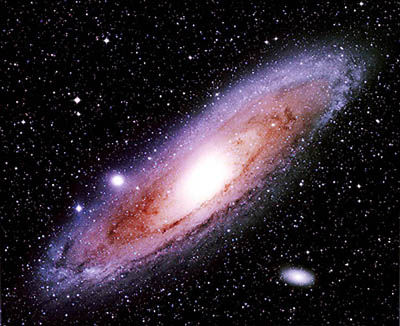
The Galactic
Alignment of December 21, 2012
Our solar system is part of a huge disc
shaped collection of stars and planets called the Milky Way. We're
located somewhere on the edge of the disc, slightly on top of the
narrow disc. But very soon we'll be moving to the bottom of the
disc. This change, from top to bottom, begins on December 21, 2012.
Yes, that's right. On the same day when our Sun is at it's solar
maximum, something will happen that's never happened before -- the
ecliptic of our solar system will intersect with the Galactic plane,
called the "Galactic Equator" of the Milky Way! [see below star
chart]

If you imagine our solar system as a
bunch of peas on a plate, with a huge meatball in the center,
imagine the Milky Way as a city-size pizza with the "Guiness World
Book Record Meatball" in its center!
Prior to December 2012 we have been drifting on the top of the
pizza, never really able to see the bottom. The plate and pizza are
not parallel. They are moving at different angles. We've been
drifting down, down, down... and on December 21st, 2012, we will be
exactly level with the crust -- forming an "x" at the Galactic
Equator where galactic gravity is the strongest. After 2012, if we
are still here, we will be passing through the bottom zone, viewing
the Milky Way pizza from the South.
Yes, there's even more!
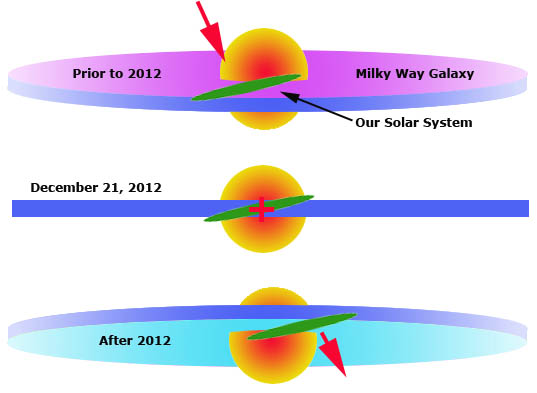
By some amazing coincidence, not only
will we be intersecting with the Galactic Equator, but we will be
doing this precisely aligned with the center of the Galaxy where
there is maximum mass! More mass means more gravity.
More gravity means more influence from
those barycenters in our Sun. That means exponential increases in
solar disruptions -- all coinciding on the same day! Whew!
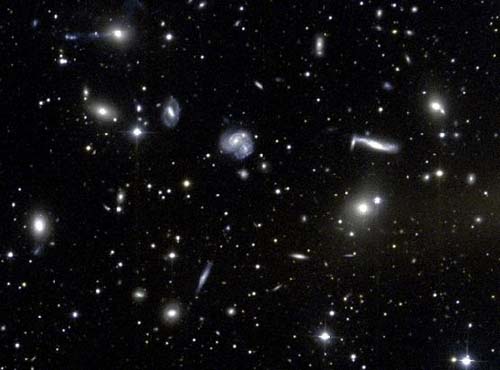
Above: The Hercules
Cluster of galaxies
This group of
galaxies is held together by the gravitational attraction or "pull"
of each individual galaxy on the others in the group.
This demonstrates the
enormous gravity contained in a galaxy, such as our own Milky Way.
An apology and
acknowledgement
Ok. This has been a "light weight" description of what's going to
happen. It has been simplified to the point where some scholars and
scientists could argue about my presentation. But the main facts are
true. The date, December 21, 2012, is a special day. It represents
the maximum possible influences for solar flares that the universe
can provide. Undoubtedly the Mayans, or the civilization that
influenced them, somehow knew about these things.
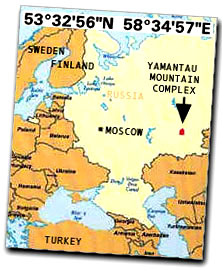
Over the last decade, I have written a variety of stories about such
things as underground cities and government actions that could only
make sense if there were no future. I cannot help but think that
maybe they, like the Mayans, know about these things. I'd
specifically like to suggest that readers take another look at
the underground complex at Yamantau
that the Russians are building.
-
Could this be a haven for
surviving a solar blast?
-
And what about past events?
-
Did
the Hopi go underground to
survive a similar event thousands of years earlier?
-
Should we be going underground
also?
It's also important to stress that
December 21, 2012 is only the "solar maximum" but that the
gravitational effects of the Galaxy have already started to assert
their influence on the Sun. The drift towards alignment with the
galactic equator is relatively slow and, in truth, has already
started. But the precise culmination of this, plus the alignment of
Jupiter and Saturn all make 12/21/12 an ominous date.
I especially want to thank Dr. Rollin Gillespie, a man with whom I
corresponded for ten years and who first developed the idea that
planetary multi-body systems could be at play in the causation of
solar flares. More of his work can be read on a special page on Viewzone.
Please let's have your input on this important issue. It's only six
years away. Who knows, perhaps the influences of these disruptions
will begin well before the solar and Galactic maximum is reached. We
may not have that much time left. Here are some additional links to
stories that may help understand the possibilities facing our planet
and us.
Magnetic
Somersaults - Other possibilities on December 21, 2012
In the first quarter of 2001, the Sun switched magnetic poles. This
occurs every eleven years. Prior to this the Sun's north magnetic
pole was at the north rotational pole. Now the Sun's north magnetic
pole is at its south pole. Since opposite poles attract, the
magnetic poles of the Earth and Sun are now at their most stable.
Just about the time of 2012 Winter Solstice, the Sun's poles will
switch back. During this switch there will be a tendency for the
Sun's magnetic field to pull the Earth's field with it.
If the Earth's magnetic poles switch, this would put stress on the
planet aggravating earthquakes and volcanoes, not to mention
destruction of the electrical power distribution grid. And, if the
switch happens fast enough don't ever expect your computer to work
again. But if you have old tube type equipment, keep it. It should
survive just fine. It will work if you can find electricity.
|














